This
is the earliest box for the Expert Wooden Minnow, or Keeling Expert. The
box isxa maroon carton with white paper label that features the 1903
patent date and a wonderful picture of the lure. The bait inside is a
gold-finish Baby Expert. This is perhaps the finest known example
of this handsome and rare box, which turned up in Oklahoma.
|
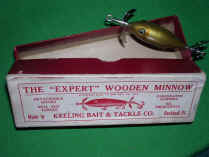 |
|
Here is a beautiful
little Tom, or "Tom Thumb" lure in a typical later Keeling box
dating to the mid 1920s. Look at all the verbage on the cover! Lots of
reading to be done there. This bait has the 1920 date on the belly keel.
Tom Thumbs are the most common Keelings, and came in an unbelievable
number of colors. new finishes are still turning up today!
|
 |
|
This is a rare box for the
Keeling Expert Minnow, one of the most desirable lures of all time.
Experts were made by other makers including F.C. Woods, Clark and
Holzwarth. The beautiful maroon papers here have all the intricacy
of an Oriental rug! The papers describe the various other Keeling
lures of the era.
|
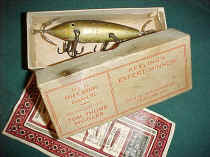 |
|
The Keeling Scout is an odd lure
that doesn't appear often. One reference describes the Scout as having a
diving lip and two line ties. This example is bulbous and has two line
ties, but no diving lip aside from the standard Keeling belly keel. Note
the yellow box with the Scout label is likely a Kee-Wig box
over-labeled. The paperwork mentions the Scout but offers no
illustration, which is a pity, as it would certainly resolve any
questions over this lure.
|
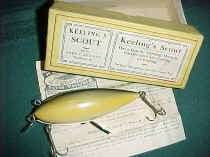 |
|
This rather long "Kee-Wig"
Keeling lure has no eyes, three trebles and is finished in a wonderful
electric red and yellow blend. The green box is a variation of the more
common red-lettered box shown above, but all keeling boxes are hard to
find and desirable. The papers inside describe the growing array
of Keeling lures and products available in this lure maker's heyday in
the early 1920s.
|
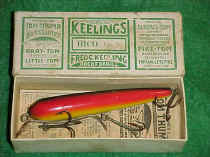 |
This is one of the rarer
Keeling lures that has glass eyes. Finished in vivid rainbow, and with
the patent date on belly, this mint lure dates to around 1920.
There is no number on the box endflap, which is typical for keeling
lures. Virtually all Keeling yellow
boxes are hard to find, and the glass eyed lures are among the most
beautiful around.
|
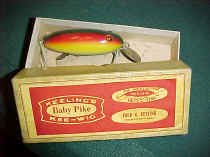 |
Here
is another Keeling with beautiful glass eyes. Note the artistic illusion
in the vertical stripes, which thicken at the top and bottom to give the
rounded body more of a vertical illusion. The paperwork calls the Pike-Kee
Wig "new," which would date this unit to the early 1920s.
|
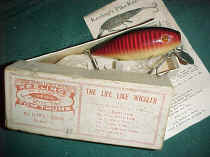 |
|
This is the earliest Tom
Thumb box and lure. Unlike the examples above, the lure appears more
crudely painted, and has no patent date on the belly keep. The box and
paperwork, however, mentjon that a patent has been applied for, and also
assert that
the lure is "new." That info places this piece around 1919.
|
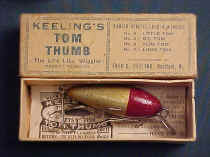 |
|
This is a slightly later Tom
Thumb and box. It differs from the one pictured above in that it claims
to be "Patented 1920" and uses a different typeface. The
beautiful paper inside shows young anglers with their catch, presumably
landed on Fred Keeling's wonderful wooden minnows! This piece once
belonged to a dear friend of mine who died of cancer in autumn of 2002.
|
 |
This is a rare
Keeling Flapper lure, circa 1922. Note the fat, pointed nose and absence
of eyes. The black scale finsih is exquisite. This lure barely fits into
the 5 1/2 inch yellow box with red lettering and a picture of the Tom
Thumb lure on the left panel.
|
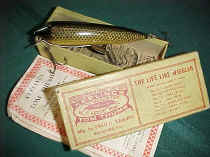 |
|
This is a rare Keeling Surface
Lure, which has no eyes, simple Keeling screw eye hook hangers and a
wonderful "Christmas Tree" paint pattern whihc is similar to
the "strawberry" paint finish on popular Heddon lures of the
day. This lure is quite minty, and the worn yellow box is much larger
than most Keeling boxes. This piece dates to around 1925.
|
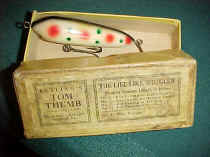 |
This is a
Keeling three-inch "Big Tom" lure in the long, white box that
was marked on the front right panel for five different Keeling lures
that could be found inside. The papers describe a seemingly endless
combination of sizes and paint finishes that were offered during this
classic era in the 1920s.
|
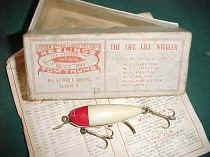 |
Here
is a wonderful trio of new-in-box Keeling Tom Thumb lures that were all
found together. Note the wonderful paint jobs and the paper flyers
inside the box bottoms. These lures sat unused for almost 75 years
before they were re-discovered in an old house, and acquired from a
visitor to this website.
|
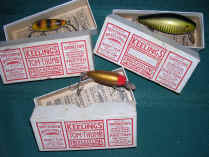 |